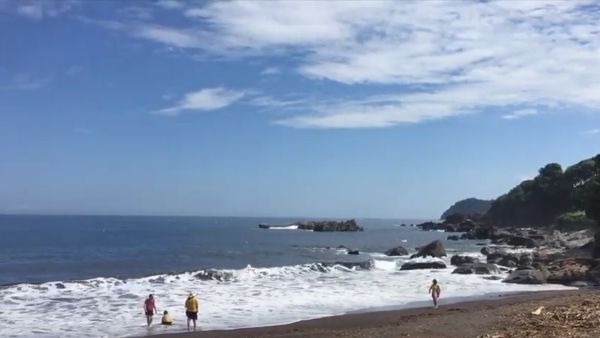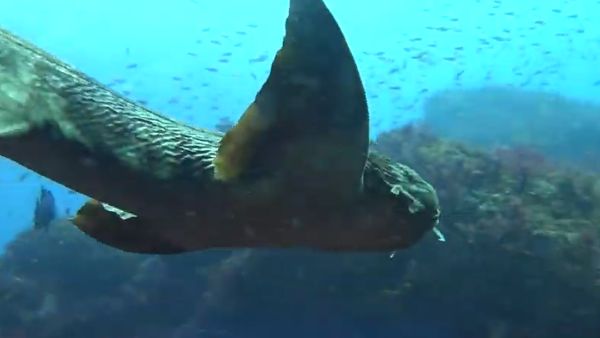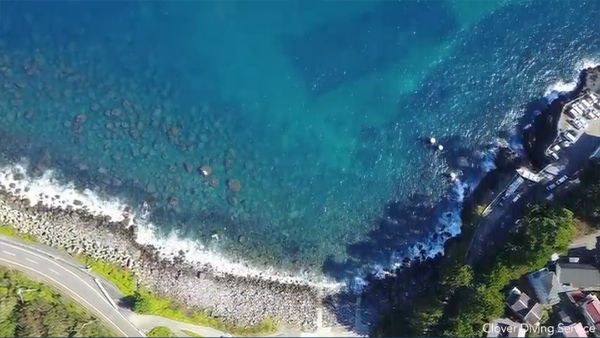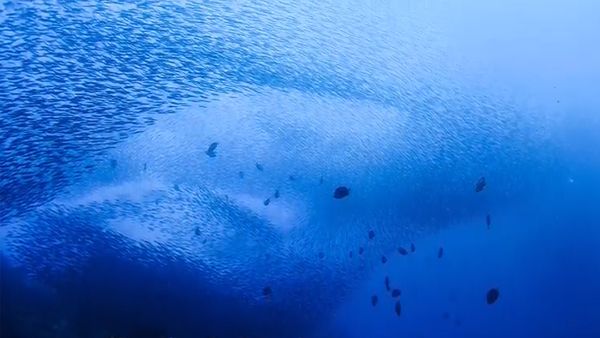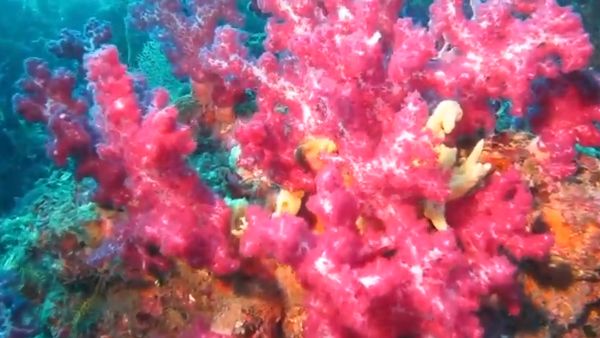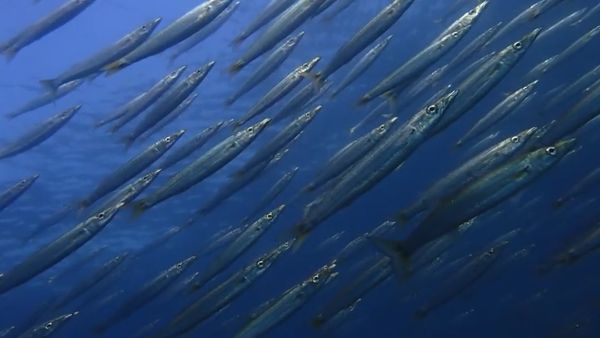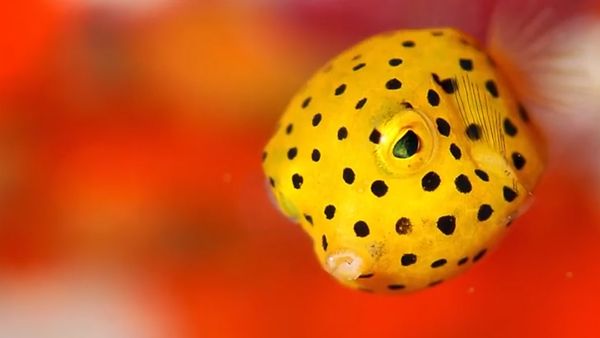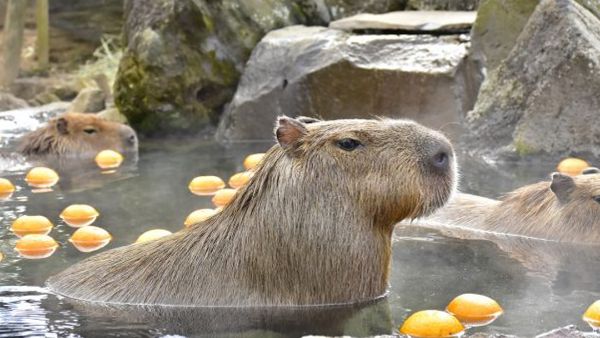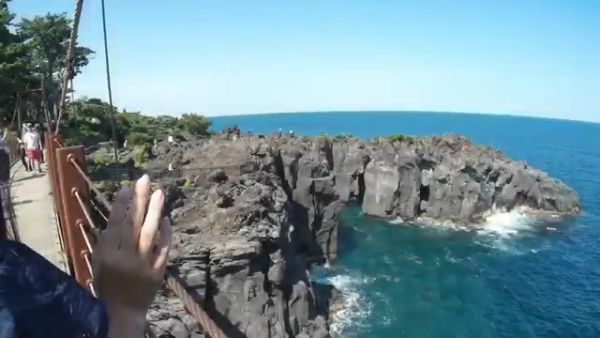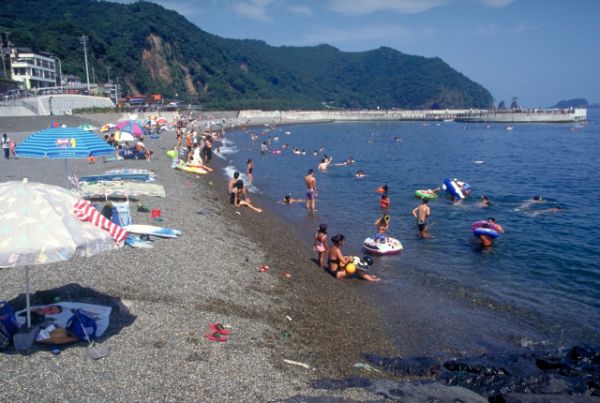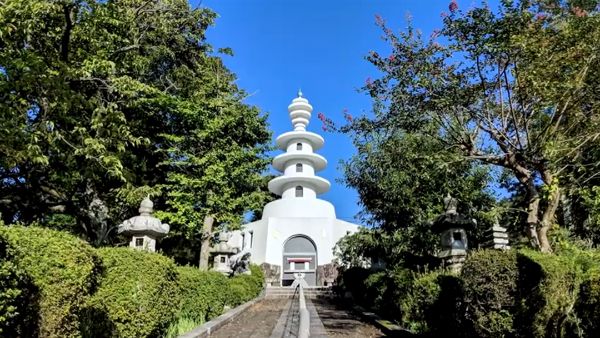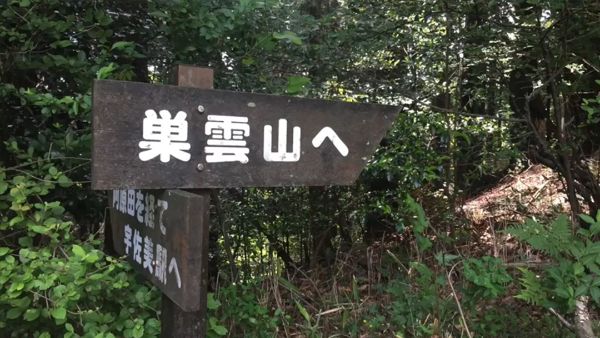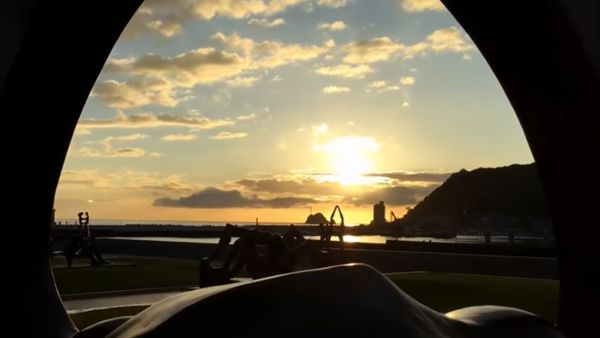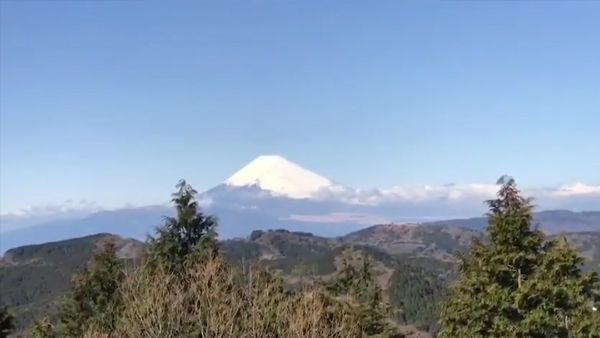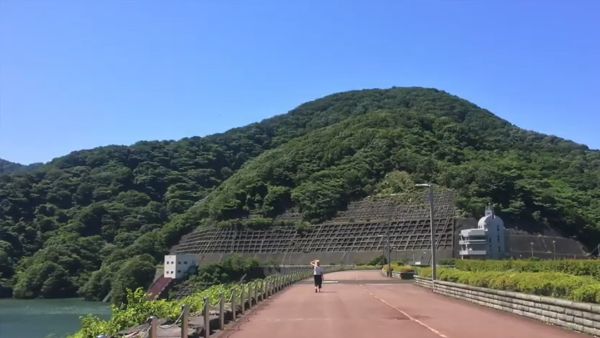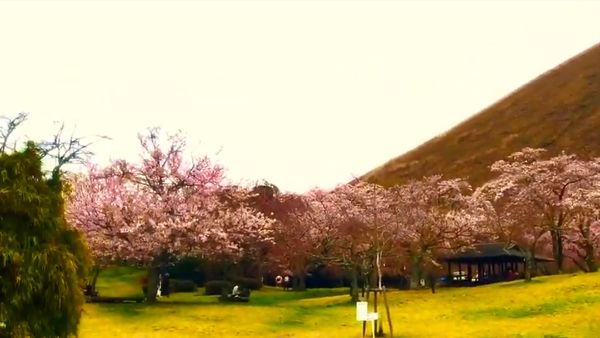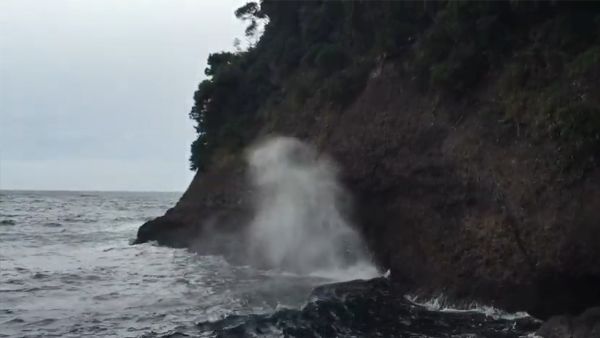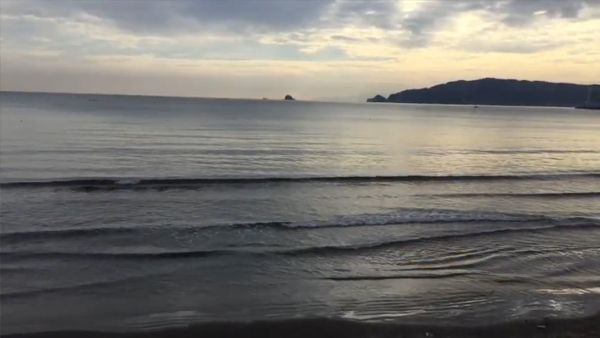Akazawa Coast
Your Own Private Ito Beach
Travelling can be a tiring and sometimes stressful experience. It is important to slow down and spend some time with those most important to you.
Akazawa Coast is a minature beach, just 100 metres by 30 meters, and is situated in the southern most tip of Ito City. It’s slightly-off-the-beaten-track location makes it a haven for those looking to avoid the crowds.
Access: 10 minutes from Izukogen station by car (taxi.) Parking is available on the left and right of the entrance.
Parking is 1000 yen a day during summer.
Address: Akazawa Ito City Shizuoka Prefecture 413-0233
Dive Spot: Akazawa Coast
Area Highlights: Calm Waters Lead to Peace of Mind for First-Time Divers
The calm waves allow for easy entrance and exit, making the Akazawa Coast an ideal spot for those diving down into the deep for the first time. The wide expanse of silky smooth sand that doesn’t cloud the water, hides a host of marine life including little cuttlefish, Japanese shame-faced crab, and blackspot razorfish fry. Due to differences in depth and type of seabed sealife found inside the harbor is quite different from that outside.
Diving Costs: 10,000 yen–30,000 yen
Dive Spot: Futo
Diving in the Futo Area
Area Highlights:
The Futo Area diving spot is one of the best for spotting many different varieties of fish. It’s perfectly suited for “fish watching” and taking diving photos underwater. Access to this diving spot is also excellent, with easy accessibility from Futo Station, Jogasaki-kaigan Station, and Izu Kogen Station. Most diving shops also offer free shuttle service from these stations. Another great thing about the Futo Area diving spot is the Onsen Maru – a fishing boat that has been renovated into a hot spring facility that allows you to take a dip with your swimsuit on.
Diving Costs: 10,000 yen–30,000 yen
Dive Spot: Ito
Area Highlights:
Volcanic rock is a common feature of the underwater landscape near Ito. Deep ravines, wide arches, and drops make up an area fascinating in its complexity. Most of the spots are located in the middle of the ocean, surrounding a uninhabited island of Teishijima 1 km off Ito shore. Other sunken islands are situated nearby. Thanks to the oceanic currents carring nutrients into the area the sea is teeming with life – you can even encounter a pod of dolphins, if you’re lucky!
Marine life to be spotted: dolphins, ocean sunfish, whale sharks.
Diving Costs: 10,000 yen–30,000 yen
Dive Spot: Izu Marine Park
Area Highlights:
Izu Marine Park was the first true diving area in Japan and it has been producing great diving guides and instructors since the sixties. The area was formed by lava from the neighboring Mt. Omuroyama Volcano. The water here is rich in diverse sealife – over 650 different species, which has earned Izu Marine Park the name of “Diver’s Field Guide”. All diving points are situated near the beach, but with various drop offs. The diverse sea bed shifting from rugged rock to pumice and sand, any point can be accessed by boat. One or two days are hardly enough to see everything that Izu Marine Park area has to offer.
Diving Costs: 10,000 yen–30,000 yen
Dive Spot: Kawana Bay
Area Highlights:
Kawana Port sits atop volcanic rocks, formed by the eruption of Komuroyama 15,000 years ago.
Diving facilities surrounding the Kawana Port, known for great catches, are exceptionally well-equiped. Only 15 minutes from Kawana Station, the diving spot allows a convenient entry directly from the beach, making it a perfect spot for beginners – but diving veterans won’t be disappointed either! Once you’re in you might even be welcomed by a dole of sea turtles.
Diving Costs: 10,000 yen–30,000 yen
Dive Spot: Usami
Area Highlights: Come face to face with the Japanese Bullhead Shark, the king of the soft coral reef.
Board a that boat takes you out into the bay and drops you directly into the Sun Fish Reef (Manbo-ne), perhaps the most beautiful spot to view the soft corals. This soft coral garden is home to a vibrant mix of sea-life of all shapes and sizes. The area is also known for the high chance of coming face-to-face with sharks and stingrays gliding through the waters. It is also the stomping ground of the king of the soft coral reef, the Japanese Bullhead Shark – despite the ferocious sounding name, this particular variety of shark greets divers with an alluring smile! These sharks are known to gather at Neko-zame Jyo where ten of them have been spotted at one time.
Diving Costs: 10,000 yen–30,000 yen
Dive Spot: Yawatano
Area highlights: A Dynamic Diving Spot to the South of Mt. Omuro
A relatively small diving area but a popular spot due to quick access from the beach and ample diving services. Yawatano bay changes along with the seasons, allowing for diving enjoyment all year round. In the spring, big reef squids come to give birth and the summer and autumn see a wealth of underwater visitors to the area. In the winter, families of clownfish can be seen keeping warm beneath the waves. At certain times of the year, night diving is also possible. The nearest station is Izu-kogen. From the station, a pick-up service for divers is available.
Diving Costs: 10,000 yen–30,000 yen
Izu Granpal Park
This recreational park with stunning illuminations is a great place to take the family!
After checking out the traditional sights of temples and enjoying your time in the Japanese countryside, you might be itching for some exciting family fun. Stop by Izu Granpal Park for a fun day at a Japanese recreational park! The rides include go-kart racing, mini golf, an obstacle course, a kids roller coaster, and more. You also can’t miss the 400-meter (there and back!) long zipline, which gives you a great birds-eye view of the park. Another main attraction that is a hit with the locals, especially in winter, are the beautiful
illuminations throughout the park.
Address: 413-0231 Shizuoka-ken, Itō-shi, Futo, 1090
www.granpal.com
+81 557-51-1122
Izu Kaiyo Marine Park
Take a trip deep down to Ito’s dynamic ocean floor
The outflow of lava after the eruption of Mt. Omuro around four thousand years ago eroded away and created a rugged underwater terrain ideal for exploration. It is therefore no surprise that this was the first Japanese dive site officially designated for scuba diving back in 1966. Those seeking to dive down into this sub-aqua playground need only take a ten minute bus ride from Izu Kogen Station bound for Ito Ocean Park. Located next to stunning views of the surrounding ocean, the park and its diving center are a must visit for all diving enthusiasts.
Ito Marine Town
Experience a special “roadside station” – one stop for shopping, dining, and hot springs!
Situated a little over a kilometer north of central Ito, Ito Marine Town is what is referred to as a “roadside station” (michi-no-eki), a rest area for drivers. However, it probably won’t look like any rest area you are familiar with – with shopping, dining, and even hot springs, this one is a tourist destination in its own right!
〒414-0002 Shizuoka-ken, Itō-shi, Yukawa, 571−19, 伊東マリンタウン オーシャンバザール棟1F
www.gionzushi.jp
+81 557-37-3366
Ito Orange Beach
Ito Orange Beach: A beach for all seasons
Located a swift 3 minutes on foot from Ito Station, Ito Orange beach is an ideal spot for thrill-seekers looking to jet-ski or those simply looking to sun worship. During the hotter months, the beach provides all the trappings of summer and it is where the Ito locals go to relax.
For those traveling outside of the bustling summer season, the beach provides a peaceful sanctuary as the crowds return home leaving open sands and a chance for contemplation. Wrap up warm for an autumnal or winter evening stroll along the sands and wait for the moon to make its lazy way into the sky. Alternatively, heading out early to view the sunrise will let you in on the colorful secret behind the beach’s name.
Japan, 〒414-0002 静岡県伊東市湯川・松原
Izu Shaboten Zoo
Get up close to the flat, furry faced idols of Ito
A nature park bursting and blooming with life, spend time among thousands of species of plant life and animal life, including the largest rodent on the planet and local Ito celebrity, the capybara.
With a history dating back to 1959, the park has grown and developed along with its inhabitants. Located next to Ito’s imposing Mt. Omuro, the park forms part of the wider geo-park. When entering the gates you soon gat a chance to connect with nature with free-roaming squirrel monkeys, among a host of other animals, darting in and out of the foliage.
1317-13 Futo, Itō-shi, Shizuoka-ken 413-0231, Japan
izushaboten.com
+81 557-51-1111
Jogasaki Coast
white sandy beaches when you have a coastline like Jogasaki?
While the word “coast” might conjure up an image of a white, sandy beach, you won’t find that at Jogasaki Coast – but what you will find is just as breathtaking.
Spiky, jagged cliffs stretch down the coast for about 9 kilometers. Lining the coast are thick forests of black pines that are native to the coastal areas of Japan, creating a picturesque, Japanese backdrop against the ocean. Adventurers rejoice – there is a nice, well-maintained hiking trail that offers amazing views as well.
The trail also includes a trek over the Kadowaki Suspension Bridge.
Futo, Ito, Shizuoka Prefecture 413-0231, Japan
www.city.ito.shizuoka.jp
+81 557-37-6105
Kawana Irukahama Park
From fishing to snorkeling, venture into the underwater world from beaches of Ito!
Only 15 min. from the Izu Kawana Station (Izu Kyūkō Line) and 20 min. from Ito Station (JR), Irukahama is a beautiful beach lying right next to Kawana Beach. It boasts crystal-clear pristine water. The beach has well-equipped facilities including toilets, showers, changing rooms, and coin lockers. Irukahama is covered by layers of round, natural gravel that is pleasant to walk on and allows you to enjoy the sea without worrying about removing sand from every piece of clothing for weeks to come.
Lake Ippeki
For those looking for an escape from the bustle of the city, look no further than the peaceful waters of Lake Ippeki
Formed after the eruption which occurred 100,000 years ago, the lake is a must visit spot for those looking to find the real beauty of the Japanese countryside. Rent a boat and row out into this large body of water to appreciate the constantly changing natural backdrop of luscious summer greens, vibrant autumn reds and every other color in between.
Lake Ippeki, Yoshida, Ito, Shizuoka Prefecture 414-0051, Japan
Maruyama Park – Firefly Watching
Understand Japanese sense of esthetics through beauty of fireflies
Maruyama Park is a 20 min. walk from Ito Station. The lush green of the trees is complemented by the murmuring of nearby Ozawa River.
Firefly Watching, organized each year in the beginning of June, is a first portent for summer to the people of Ito. The Japanese perceive the faint light of a firefly as a thing of heartbreaking beauty.
Firefly watching hours: 19:30~21:00
Address: 414-0006 Shizuoka-ken, Itō-shi, Matsubara, Nagamine
Matsukawa River
The Lifeblood of Ito City
Around a 10-minute walk from Ito Station, the Matsukawa River flows all throughout the town of Ito. Walking along the river and enjoying the sights and sounds of the town has long been a favorite activity of Ito locals. Next to the river you’ll find Tokaikan, the 3-story hot springs building named a designated cultural property, which will make you feel like you’ve slipped back into time.
As you walk along the Matsukawa River lined with willows and cherry blossom trees, you’ll come across Kawaguchi Park, where you’ll encounter wild birds and carp. From fall to spring, you can also see kingfishers, wagtails, spot-billed ducks, and different species of seagull.
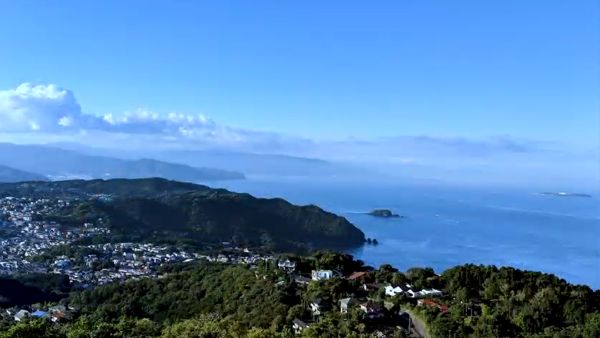
Mt. Komuro
Where Spring is Sprung All Year Round
You may think that flowers only appear for fleeting moments in the spring and summer, but the Ito natural park with 321m Mt. Komuro as its centerpiece is in bloom all year round. The famous members of the Japanese flower lineup take turns to blossom and bloom throughout the year including plum, cherry blossom, hydrangeas and azaleas. A particular spot of floral magnificence happens at the end of April, early May at the foot of the mountain on the west side. About 100,000 azalea trees have been planted over 35,000 square meters. The area transforms into a red carpet that contrasts spectacularly with the looming Mt. Fuji.
Mt. Komuro Chair Lift
One of the icons of the Ito area, Mt. Komuro is a smaller mountain that gives you incredible views of the surrounding area from the summit. At only 320 meters, it’s small enough to climb, but we recommend taking the lift up to the top! It only takes 3 minutes to reach the top, and one you are there, you are rewarded with breathtaking views. From there, enjoy the crsip, cool mountain air as you gaze upon Sagami Bay, Izu Peninsula, Mt. Omuro, and even Mt. Fuji, on of the most popular icons in Japan.
Hours:
March 16 – May 15, 8:30 am to 4:30 pm
May 16 – September 15, 9:30 am to 4:00 pm
September 16 to November 15, 9:00 am to 4:00 pm
November 16 to March 15, 9:30 am to 4:00 pm
Address: 1428 Komuroyama, Kawana, Ito City, Shizuoka Prefecture 414-0044
Phone: 0557-45-1444
Mt. Sukumo
A Mountain Made of Rice
Mt. Sukumo, standing at an altitude of 581m spans the three cities of Ito, Izunokuni and Izu. It might not be the highest mountain in the region, but clear views of the seven islands of Izu Shichito, the Amagi mountain range, Mt. Fuji and Hakone make it a popular site for lovers of the great outdoors. The sukumo in the mountain’s name means “rice husk” and legend states that farmers from the rich lands to the west of the mountain would throw their unwanted husks here. The discarded husks built up to such an extent that they became the mountain that stands today.
Address: Shizuoka Prefecture, Izu City, Shimoshiraiwa
Nagisa Park
Peace, happiness and sculpture at Nagisa Park
With an ocean backdrop and adorned with sculpture, Nagisa Park should be on every Ito visitor’s to-do list. Commissioned in 1977 to commemorate 30years of Ito’s municipality, the sculptures were created by local artist Kenji Shigeoka. Shigeoka is still active as an artist and his general concept is to create art that can be touched but not break, therefore his large sculptures in Nagisa Park are strikingly sturdy and robust.
〒414-0022 Shizuoka-ken, Itō-shi, Higashimatsubarachō
Ohira no Mori Walking Course
Get Outdoors. Get Walking.
Leave four wheels behind and stretch your two legs on the walking trail behind Ito Station. Before long, you will find yourself climbing up towards Maruyama Park – home to Ito’s luminary residents, the fireflies – and further on into the great outdoors. The five hour round trip that takes you to the heart of Ohira no Mori allows for views of the surrounding hills and mountains, as well as the town below.
Okuno Dam
A beautiful park nestled in the middle of nature
Okuno Dam, the only rockfill dam in the Izu Peninsula, supplies drinking water to the city of Ito. The construction of Okuno Dam gave way to the creation of Lake Matsukawa. Here you can also find Okuno Park, which is very popular with families thanks to its spots where you can view flowers and play in the water.
For those into walking and jogging, there is also a 5 kilometer long path that goes around the exterior of Okuno Dam which allows visitors to enjoy the changes of the seasons.
Sakura no Sato
On the coveted list of 100 top cherry blossom (sakura) viewing spots in Japan, Sakura no Sato is a must-visit
The cherry blossom is the most eagerly anticipated event of spring. Holding a picnic under a blooming cherry blossom tree has been part of Japanese culture for centuries. While the most spectacular season of full bloom can be a fleeting few days in April, those visiting in a different season needn’t despair. You can still be immersed in cherry blossom at Sakura no Sato, as the 40,000 square meter area is home to 40 types of blossom bursting into color at different times of the year.
Shiofuki Park
Don’t miss the thrilling Shiofuki-Iwa that you can only see in Ito!
Shiofuki Park, which can be found on the way to Kawana Port from Ito Port, is best known for Shiofuki-Iwa, or “Spouting Rock”. During high tide, there is a loud thunderous boom along with a magnificent spray of water from the cave caused by the ebb and flow of the tide, which gives it the name Shiofuki-Iwa. It’s a great spot to take a look at one of the dynamic aspects of nature up close. This spot is surrounded by rocky beach, and you can have fun looking for shells in the clear ocean on days when it is calm.
Address: Close to Arai, Ito, Shizuoka Prefecture 414-0043
Tajima Waterfall
phantom waterfall – fortune strikes those lucky enough to catch a glimpse
Tajima waterfall drops the clear water of the Tajima River directly into the sea. It is an extremely rare sight and only to be seen in Ito’s Geo-Park. Take a moment to drink in the sight and sound of water plummeting down into the Jogasaki coast; an area created 4000 years ago from lava flow. No hyperbole is needed to explain why Ito takes so much pride in this area.
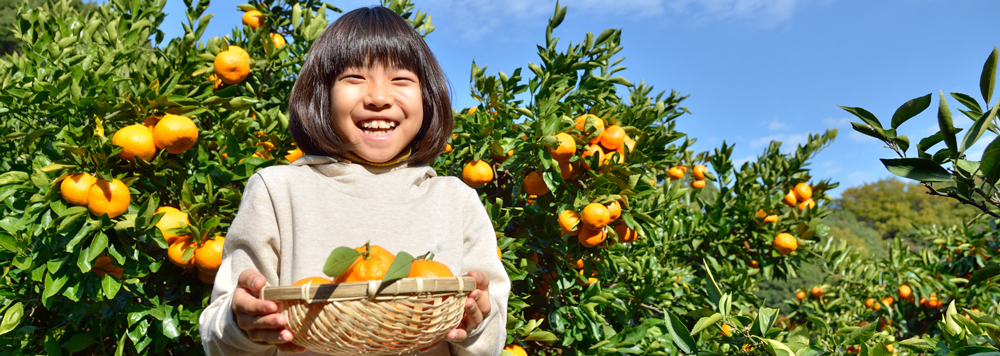
Usami Nouen (Mandarin Orange Picking)
Get lost in the largest mandarin orange (mikan) grove on the Izu Peninsula
You might think of fruit picking as hard seasonal graft for cash strapped students, however there is beauty to be found among the gnarled, tangled orange trees.
Usami Nouen is a haven for lovers of the sweet orange fruit, pick from the four, seasonal varieties blooming at different times throughout the year. From the “sweet spring” in the winter months to the “sweet summer mikan” at the end of June, experience the distinct taste of each orange – a taste that changes from tree to tree. With a history going back over a century, the grove has winded its way through a hundred years of trial and error and those in charge continue to strive for the perfect mikan through pesticide-free organic cultivation.
3506-2 Usami, Itō-shi, Shizuoka-ken 414-0001, Japan
Usami Beach
Have a blast at one of the largest beaches on the Izu Peninsula!
Located only 5 minutes away from Usami Station, Usami Beach is one of the largest beaches on the Izu Peninsula, with a white sandy beach that stretches over 1.5 kilometers. It’s a great place for playing in the sand, or gathering seashells. Usami Beach is also popular as a surfing spot, with local surfers gathering on mornings and evenings when the waves are big.
Address: Usami, Ito City, Shizuoka Prefecture 413-0111
